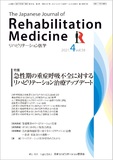Japanese
English
- 販売していません
- Abstract 文献概要
- 1ページ目 Look Inside
- 参考文献 Reference
はじめに
注意機能は「必要な標的に着目して,情報を処理,入力,出力する脳機能のプロセス」といわれている1).Sohlbergによると,注意機能には課題に集中し続けるための「持続性」,多数の情報から必要な情報を選択するための「選択性」,あることから他のことに注意を切り替えるための「転換性」,複数のことに同時に注意を向けるための「配分性」の4分類があるとされ1-2),臨床的にもこの分類に基づき整理されることが多い.これらの注意機能は,くも膜下出血や脳卒中,頭部外傷などによる脳の器質的損傷などに起因して障害される.注意障害は高次脳機能障害を有する患者の約80%に認められるとする報告もあり,日常生活や社会生活,リハビリテーション治療の阻害要因となるため治療・改善が重要とされている1-4).主な治療法として,机上での課題非特異的な訓練や課題指向型訓練,環境調整などによる機能適応アプローチが存在するが,特に重度の注意障害患者では環境調整や課題難易度調節による工夫を行ってもリハビリテーション治療の実施が困難な場合も多く,重度注意障害患者へのアプローチ手法の確立は臨床的な課題である1-4).一方で,特に高次脳機能障害を含む認知障害患者に対しては,近年海外を中心に仮想現実(virtual reality:VR)技術を用いたリハビリテーション治療の応用が始まっており,実際にシステマティックレビューなどでも視覚性注意障害の改善効果などが報告されているため,この分野における応用が期待される5-6).本邦においては2019年3月末にVRを用いたリハビリテーション用医療機器「mediVRカグラ」の販売が開始され,VRの臨床応用が可能となった7-8).今回われわれは,重度注意障害を呈したくも膜下出血患者に対してVRを利用したリハビリテーション治療を行い,注意機能指標および臨床症状が改善した症例を経験したので報告する.なお,今回の報告に関して患者本人から書面で同意を得ている.
Objective:It is often difficult to provide effective functional training in patients with severe attention deficit caused by organic damage to the brain. Herein, we report a case of attention deficit in a patient with subarachnoid hemorrhage, which was successfully treated by virtual reality (VR)-guided rehabilitation.
Methods:A 71-year-old woman was transferred to our hospital for rehabilitation after a subarachnoid hemorrhage. The patient suffered from severe attention deficit. She was unable to follow instructions from therapists and was unable to concentrate on rehabilitation tasks. We attempted VR-guided rehabilitation using mediVR KAGURA (mediVR, Toyonaka, Japan) in order to improve her attention deficit. The training was performed approximately 20 min every weekday, for 4 months in a 360-degree VR environment, with no background image initially. The difficulties in physical and cognitive tasks were adjusted by focusing on the size, range of appearance, and falling speed of each task object, so that even patients with severe attention deficit could respond to these tasks appropriately.
Results:After the above-mentioned VR-guided training, the trail making test A, behavioral inattention test, and moss attention rating scale were improved from 300 s (could not complete the test) to 100 s, 119 to 133, and 55 to 98, respectively. In addition, in the clinical assessment for attention, the time required for visual obliteration tests was significantly shortened, and clinical symptoms associated with attention deficit were also improved clinically.
Conclusion:VR-guided rehabilitation has the potential to be used as a new therapeutic approach to improve attention deficit.

Copyright © 2021, The Japanese Association of Rehabilitation Medicine. All rights reserved.


